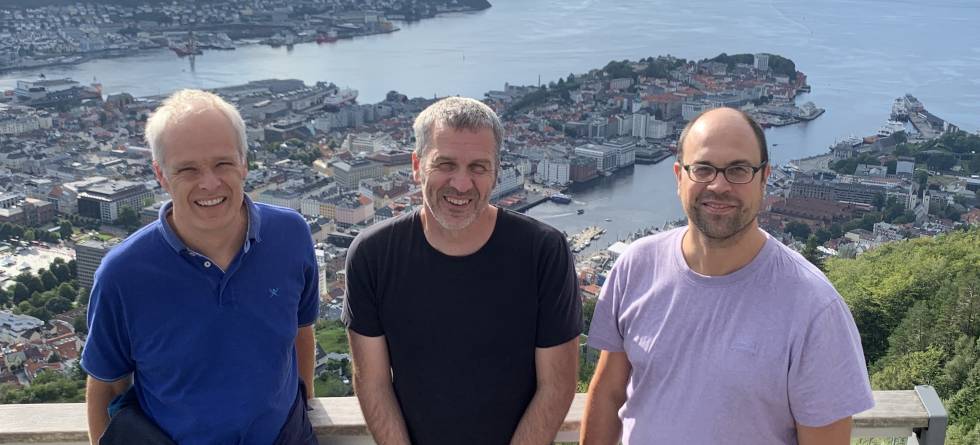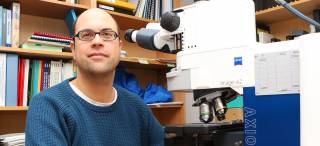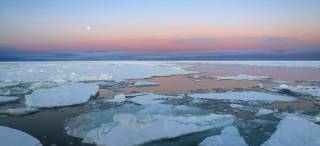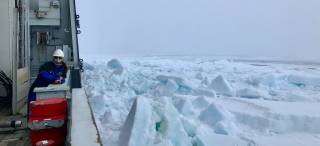Press release by AWI, UIT, NORCE and BCCR
What are the global impacts of an ice-free Arctic? How will the Arctic develop with increasing climate warming? What does an ice-free Arctic mean for our environment and our society? Researchers want to answer these questions with the "i2B - Into the Blue" project, looking back to the past and forward to the future. This project has now been funded with 12.5 million euros by a Synergy Grant from the European Research Council (ERC) for six years. The project's proposers are Dr Jochen Knies and Research Prof Dr Stijn De Schepper from Norway, and climate modeler Prof Dr Gerrit Lohmann from the Alfred Wegener Institute and the University of Bremen
The impact of a melting Arctic has long preoccupied researchers, because the concrete effects on the region and the entire earth system have so far been unclear. This is precisely the question that the "i2B - Into the Blue" project wants to get to the bottom of by taking a look into the past, to time periods warmer-than-present (i.e. Pleistocene interglacials, the Pliocene, and the Miocene) when the Arctic lost its white landscape and had a blue, ice-free ocean. To this end, expeditions to the Arctic are planned in order to quantify the changes from climate archives. Currently, the dynamics of changes in sea ice and land ice and the feedback with the environment have not been sufficiently analyzed. Thus, important aspects for climate projections in the Arctic are missing. The project now aims to make up for this.
"The timeliness of i2B is associated with the acquisition of new geological data in the Arctic for warm periods in combination with novel climate models integrated in a concerted framework beyond the state of the art", the three researchers describe their project.
"The i2B project consists of three parts that build on each other: quantifying, understanding, and the impact of a blue Arctic," Dr Jochen Knies from the UIT The Arctic University of Norway explains.
The researchers will analyze how ice distribution and ecosystems evolved in past "greenhouse" periods that were warmer than today.
"New models are being developed to better understand the dynamics of change in the Arctic,” adds Prof Dr Gerrit Lohmann from the Alfred Wegener Institute, Helmholtz Centre for Polar and Marine Research (AWI), and the University of Bremen.
"Together, this will then allow an assessment of the impact of Arctic change on the environment and society in the coming decades," Dr De Schepper, Research Prof at the Norwegian Research Centre (NORCE) and Bjerknes Centre for Climate Research emphasizes.

The researchers together with their co-leads Dr Petra Langebroek (NORCE), Dr Juliane Müller (AWI), and Associate Prof Dr Monica Winsborrow (UiT) will lead an international team. Knies, De Schepper and Lohmann bring together their different expertise. This allows for a synergistic project of paleoclimatic, environmental science and marine geology research.
“We currently lack a comprehensive understanding of how the loss of the Arctic's white landscapes will impact our climate, the planet and our society. In this new project, researchers want to extract images from the past for our future.Together with our Norwegian partners, we are very pleased about the Synergy Grant, as the ERC funding is a great opportunity for all of us to get answers to this”, says AWI Director Prof Dr Antje Boetius.
She is also pleased that this ERC Synergy Grant, together with two other Synergy Grants for Earth system researchers, will go to the MARUM – Center for Marine Environmental Sciences at the University of Bremen.
“A sign that we have built a top location for climate and marine research here in the state of Bremen and are very good at attracting national and international talents.”
“The ERC Synergy Grant is the most prestigious research grant in Europe, and until now only seven such projects have been funded in Norway. We compete with the most excellent research institutions internationally, so I am deeply impressed and proud on behalf of everyone. NORCE is delighted to provide our expertise on paleoceanography, ancient DNA, and sea ice reconstruction into this project.”, says Dr. Trond Dokken, Executive Vice President for the Climate & Environment division at NORCE.
“Getting this grant is an enormous achievement by the three excellent researchers and their institutions. The Arctic is a hot spot for rapid climate change, and getting knowledge about the possible futures that might await us is of the utmost importance. i2B is a great inspiration to us all,” says Prorector for Research and Innovation, Prof. Dr. Jan-Gunnar Winther, of UiT The Arctic University of Norway.
The European Research Council annually funds scientific projects from the European Union with the Synergy Grant. The projects are intended to explore interfaces between established disciplines and thus lead to significant scientific advancements. Eligible applicants are groups of two to four people working together to pool their knowledge and resources to address challenging research questions.




